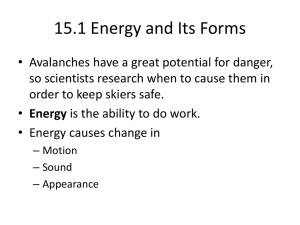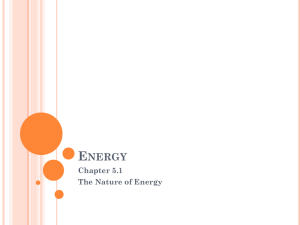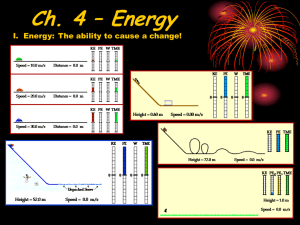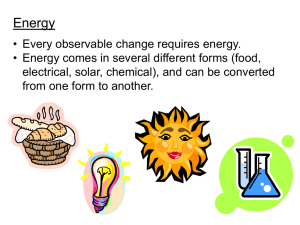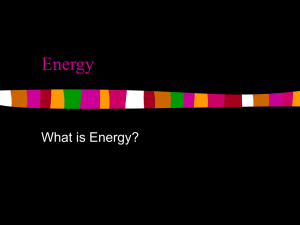Energy
advertisement
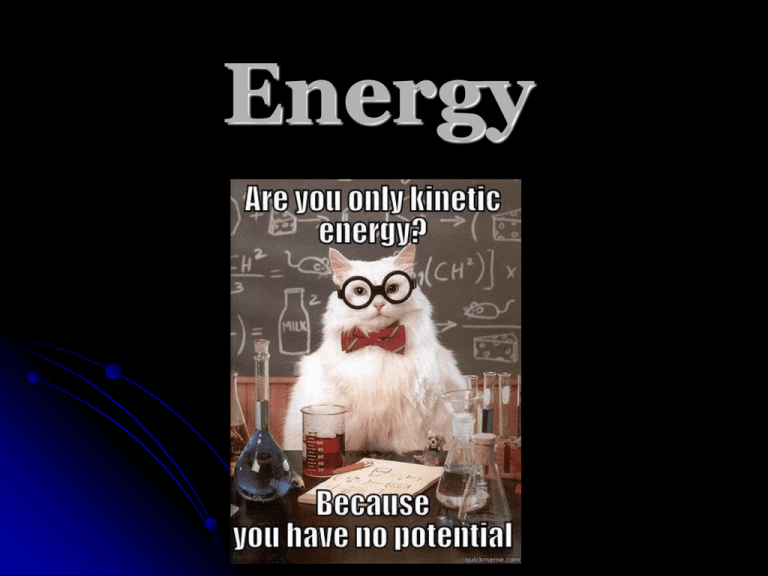
Energy Energy Energy Any is the ability to do work. object that has energy has the ability to create force. Energy There are many different forms of energy: Mechanical Energy Radiant Energy (Light) Nuclear Energy Electrical Energy Chemical Energy Thermal Energy (Heat) Pressure Energy Etc… Energy All forms of energy can be classified into Potential or Kinetic. Energy Potential energy is the stored energy of position possessed by an object. Energy Gravitational potential energy (GPE) is the energy stored in an object as the result of its vertical position or height. Energy These are both the same formula, but the top one is how it looks on your formula chart. Make note of units. Energy What has more GPE, a rock at the top of a a 50 m ramp or a rock on the top of a 55 m ramp? If you double the height a stone that is being held above the ground, what happens to its GPE? If you half the height a stone that is being held above the ground, what happens to its GPE? Energy A 2 kg dog is at the top of a 3 m tall slide. Calculate his GPE. Energy A 2 kg dog is at the top of a 3 m tall slide. Calculate his GPE. m= 2 kg g= 9.8 m/s2 h= 3 m GPE = mgh GPE = (2)(9.8)(3) GPE = 58.8 J Energy Elastic potential energy (PEe) is the energy stored in elastic materials as the result of their stretching or compressing. Elastic potential energy is stored in the spring when stretched (more stretch=more energy) If a spring is not stretched or compressed no potential energy is being stored; it is in equilibrium Energy k = Spring constant (N/m) The stiffer the spring, the larger the spring constant x = Amount of compression relative to the equilibrium position Energy A spring is stretched 0.2 m from equilibrium. The force constant (k) of the spring is 2500 N/m. What is the potential energy of the spring? Energy A spring is stretched 0.2 m from equilibrium. The force constant (k) of the spring is 2500 N/m. What is the potential energy of the spring? k= 2500 N/m x= .2 m PEe= ½(2500)(.2)2 PEe= 50 J Energy Kinetic energy (KE) is the energy of motion. The more an object moves, the more kinetic energy it has. Energy Again, these are both the same formula, but the top one is how it looks on your formula chart. Energy Determine the kinetic energy of a 625-kg roller coaster car that is moving with a speed of 18.3 m/s. Energy Determine the kinetic energy of a 625 kg roller coaster car that is moving with a speed of 18.3 m/s. m= 625 kg v= 18.3 m/s KE= ½ mv2 KE = ½ (625)(18.3)2 KE = 104,653.13 J Energy Mechanical energy is the energy that is possessed by an object due to its motion or due to its position. It can be kinetic or potential. Total Mechanical Energy (TME)= Potential Energy+ Kinetic Energy • TME= (½ mv2)+(mgh) Energy TME= (½ mv2)+(mgh) • A golfer hits a 0.4kg golf ball with a speed of 0.4m/s to a height of 30 m. What is the golf ball's total mechanical energy? TME= (½ mv2)+(mgh) • A golfer hits a 0.4kg golf ball with a speed of 0.4m/s to a height of 30 m. What is the golf ball's total mechanical energy? m= .4 kg v= .4 m/s g= 9.8 m/s2 h= 30 m TME= (½ mv2)+(mgh) TME = (½*.4*.42)+(.4*9.8*30) TME = 117.63 J Energy The Law of Conservation of Energy: the total amount of energy in an isolated system remains constant over time energy can neither be created nor destroyed: it can only be transformed from one state to another. Remember the Lion King slide… Energy ((½ mv2)i+(mgh)i) = ((½ mv2)f+(mgh)f) Energy Julie has a mass of 49 kg. What is her potential energy when standing on the 6 meter diving board? (She is 6 meters above the water.) Julie jumps off the diving board. What is her kinetic energy just before she hits the water? Julie has a mass of 49 kg. What is her potential energy when standing on the 6 meter diving board? (She is 6 meters above the water.) m= 49 kg h= 6 m g= 9.8 m/s2 GPE =(49)(9.8)(6) GPE = 2,881.2 J This is her Initial GPE (PEi). Julie has a mass of 49 kg. What is her kinetic energy just before she hits the water? m= 49 kg h= 6 m g= 9.8 m/s2 GPEi= 2,881.2 J KEi= 0 J GPEf= 0 J 0 + 2,881.2 = KEf + 0 2,881.2 = KEf Energy Work-Energy Principle - The change in the kinetic energy of an object is equal to the net work done on the object. W = (½ mv2)f - (½ mv2)i W = (½ mv2)f - (½ mv2)i A toy car with a mass of 2 kg starts at rest. A spring performs 196 joules of work on the car. What is the toy car’s final velocity? W = (½ mv2)f - (½ mv2)i A toy car with a mass of 2 kg starts at rest. A spring performs 196 joules of work on the car. What is the toy car’s final velocity? m= 2 vi= 0 E=196 vf= ? 196 = (½ 2*vf2) - (½ 2*02) 196 = (1*vf2) – (0) √196= √vf2 14=vf Energy Energy

